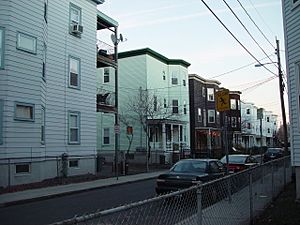Cambridgeport, Cambridge, Massachusetts facts for kids
Cambridgeport is a lively neighborhood in Cambridge, Massachusetts. It's located near the Charles River, which makes it a scenic place. The neighborhood is bordered by Massachusetts Avenue, the Charles River, the Grand Junction Railroad, and River Street. You'll find many homes here, especially the unique "triple decker" style, which are common in New England.
At the northern end of Cambridgeport is Central Square. It's a busy area with lots of shops, restaurants, and places to catch public transportation. The neighborhood also includes University Park, which has modern office buildings and apartments. Plus, you can visit Fort Washington Park, some MIT buildings, and Magazine Beach for outdoor fun. Cambridgeport is known as Area 5 within the city of Cambridge.
A Look Back: Cambridgeport's History
Cambridgeport was once a large marshy area connected to the Charles River. Over time, it grew and became an important part of Cambridge's local government. Many of the names you see around the neighborhood today come from its early days.
Did you know a famous cookie was first made here? The Fig Newton cookie was created in Cambridgeport in 1891 at the F. A. Kennedy Steam Bakery. It was named after nearby Newton, Massachusetts!
Years ago, there were plans to build a big highway called the "Inner Belt" right through parts of Cambridgeport. This project was first suggested in 1948. However, many people in the community protested against it. Because of these strong protests and a decision by Governor Francis Sargent in 1970 to stop new highway building inside Route 128, the highway project was finally canceled in 1971. This showed how much power local communities have when they work together!
Who Lives Here: Demographics
In 2010, about 12,220 people lived in Cambridgeport, in 5,391 homes. The average household income has grown over the years. In 1999, it was around $45,294, and by 2020, it had increased to about $86,800.
Learning in Cambridgeport: Education
The Cambridge Public Schools system runs the Cambridgeport School. This school teaches elementary school students.
The Cambridgeport School first opened its doors in 1990. There was a proposal in 1997 to close the school, but it stayed open. Since about 2001, the school has been located in the building that used to be the Fletcher School.


